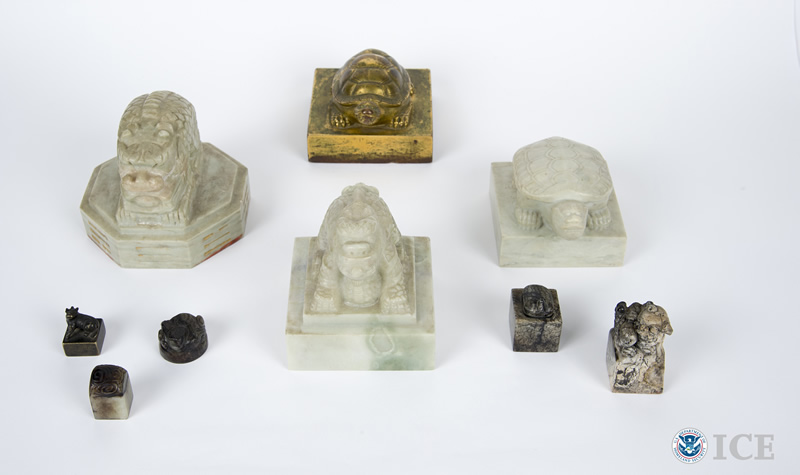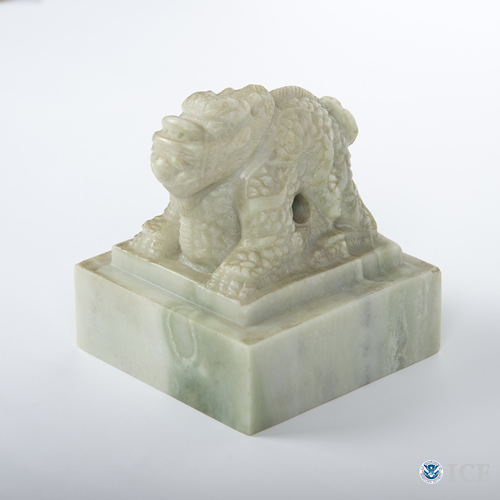ICE returns 9 ancient Korean artifacts to South Korea
WASHINGTON — More than six decades after being removed during the Korean War, nine royal seals of the Korean Empire and Joseon Dynasty were repatriated Friday to Seoul, South Korea, by U.S. Immigration and Customs Enforcement's (ICE) Homeland Security Investigations (HSI), coinciding with U.S. President Barack Obama's visit to that nation.
HSI San Diego special agents seized the cultural artifacts in November 2013 as part of a joint investigation with HSI Attaché Seoul. The South Korean Cultural Heritage Administration (CHA) and the Supreme Prosecutors' Office (SPO) assisted with the investigation.
"National treasures are an integral part of the fabric of any nation and they should never be sold or hidden," said Principal Deputy Assistant Secretary Thomas S. Winkowski. "ICE is proud to have played a significant role in the return of these priceless royal seals to the people of Korea."
"HSI's international cultural property investigation was truly unparalleled," said CHA's Administrator Sun-hwa Rah. "CHA is sincerely grateful to the HSI special agents who contributed to this investigation. Hwangjejibo, the Emperor's Seal of the Korean Empire, is priceless to South Korea as it represents the national dignity and pride of South Korea and its citizens. CHA will continue to work closely with HSI for all future cultural property cases with a nexus to the United States."
The seals were turned over to HSI San Diego special agents in November 2013 by the family of a deceased Marine lieutenant, who had served in the Korean War. The lieutenant found the seals in 1950 in a ditch near the Deoksugung Palace, which had been ransacked by Chinese and North Korean soldiers.
The nine seals include three national seals of the Korean Empire, one royal seal of the Korean Empire and five signets of the Joseon Royal Court of the Joseon Dynasty. The Korean Empire (1897-1910) succeeded the Joseon Dynasty (1392-1910).
The Korean government makes two main types of seals – national and royal seals. National seals are made for practical uses, mostly to stamp official government documents. Royal seals commemorate royal rituals. Among the seals seized were Hwangjejibo (Seal of Emperor), the national seal made upon an establishment of the Korean Empire in 1897, and Sugangtaehwangjebo (Royal Seal of ex-Emperor Sugang), the royal seal carved to commemorate the 1907 royal ritual. The government of the Korean Empire used the Yuseojibo (Seal of Yuseo) and Junmyeongjibo (Seal of Junmyeong) for official purposes such as appointing government officials. Five other signets were used to stamp on books or paintings in the Joseon Royal Court.
The emperor's seal is classified as a national treasure by South Korea.
In September 2013, a Washington, D.C.-based antiquities expert contacted HSI Washington special agents to say that a man residing in Escondido, Calif., had contacted them to see if the seals were valuable. HSI Washington forwarded photographs of the seals to an antiquities expert at HSI Attaché Seoul, who provided the photographs to the CHA. The CHA subsequently determined that the seals appeared to be official seals of the Joseon Dynasty.
In October 2013, the CHA and the SPO International Cooperation Center (ICC) requested HSI's assistance in recovering the seals.
HSI Attaché Seoul asked HSI San Diego to locate and recover the cultural property, which was illegally exported into the United States. Subsequently, the family voluntarily turned over the seals to HSI for return to South Korea.
On Feb. 14, 1983, South Korea became a signature country to the 1970 United Nations Educational, Scientific and Cultural Organization (UNESCO) Convention on the Means of Prohibiting and Preventing the Illicit Import, Export and Transfer of Ownership of Cultural Property. The Korean National Property Act, enacted April 8, 1950, and the Korean National Property Act-Enforcement Decree, enacted June 10, 1950, include the country's cultural patrimony laws. According to the Korean National Property Act, the aforementioned seals fall under the category of Korean national property, which is illegal to transfer or export.
View more photos of the Korean Empire and Joseon Dynasty royal seals on ICE's DVIDS page.
HSI plays a leading role in criminal investigations that involve the illegal importation and distribution of cultural property, including the illicit trafficking of cultural property, especially objects that have been reported lost or stolen. The HSI Office of International Affairs, through its 67 attaché offices in 48 countries, works closely with foreign governments to conduct joint investigations.
HSI specially trained investigators, assigned to both domestic and international offices, partner with governments, agencies and experts to protect cultural antiquities. They also provide cultural property investigative training to law enforcement partners for crimes involving stolen property and art, and how to best enforce the law to recover these items when they emerge in the marketplace.
Since 2007, more than 7,150 artifacts have been returned to 27 countries, including paintings from France, Germany, Poland and Austria, 15th to 18th century manuscripts from Italy and Peru, as well as cultural artifacts from China, Cambodia and Iraq.
Learn more about HSI cultural property, art and antiquities investigations. Members of the public who have information about suspected stolen cultural property are urged to call the toll-free HSI tip line at 1-866-DHS-2-ICE, or to complete its online tip form.



